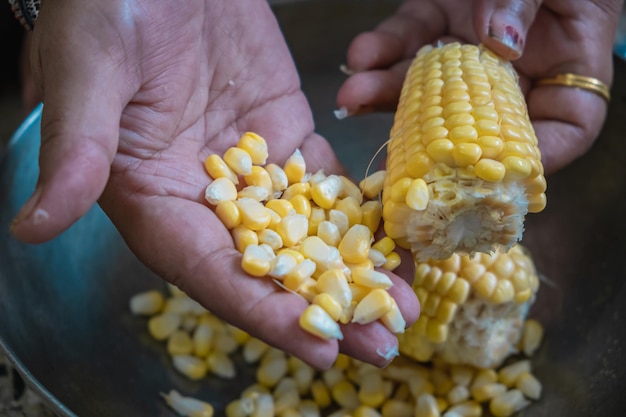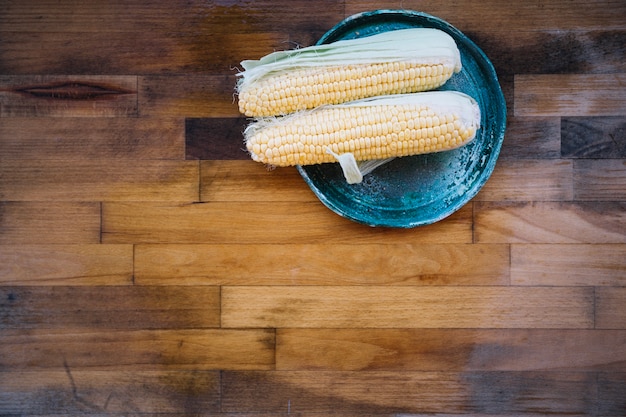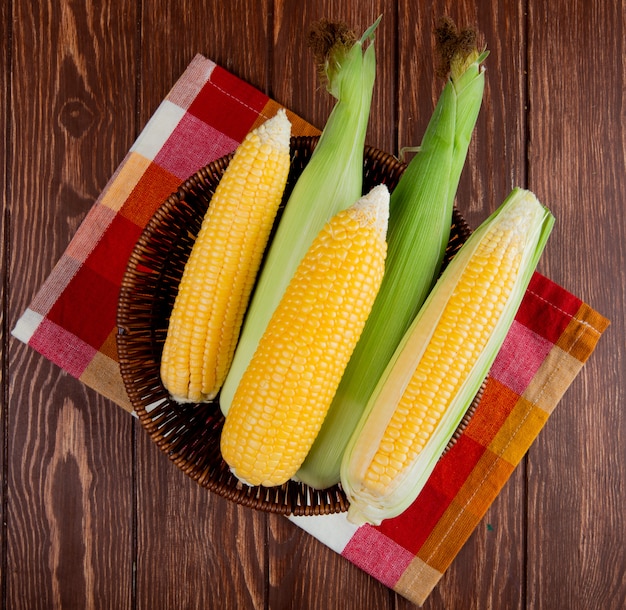Ah, summer. The sun's beaming, the birds are chirping, and the enticing aroma of BBQ smoke fills the air. What's a summer feast without a platter brimming with sweet, juicy corn on the cob? But how do you achieve that perfect balance of tender kernels and a delightful char? It's all about timing, my friends. Let me tell you, I've spent years experimenting, from undercooked and raw to overcooked and mushy, until I finally cracked the code for the ideal cooking time. And trust me, getting it right makes all the difference.
(Part 1) The Basics: Understanding Your Corn

Before diving into cooking techniques, we need to understand the type of corn we're working with. It's not a one-size-fits-all scenario. Freshly picked corn, the kind you find at a farm stand or farmers' market, cooks differently than frozen corn or canned corn. Let's break it down:
fresh corn: The Epitome of Flavor
Fresh corn is the ultimate choice, offering that vibrant, sweet flavor that's simply irresistible. However, it requires a bit more attention. The cooking time for fresh corn varies depending on its maturity. If the kernels are milky and soft, they'll need a shorter cook time. But if they're firmer and more yellow, you'll need to cook them a little longer. We'll delve into specific timings later.
Frozen Corn: A Convenient Solution
Frozen corn is a lifesaver when time is tight or fresh corn is unavailable. It's already been blanched, so it cooks quickly. However, since it's been frozen, it might lose some of its natural flavor and texture. We'll discuss how to make the most of frozen corn in the coming sections.
Canned Corn: The budget-friendly Option
Canned corn is an affordable choice that's always readily available. It's already cooked, but it can be a bit mushy. Canned corn is best utilized in salads or as a topping rather than as corn on the cob. But if you do want to try it, we'll provide tips to avoid that mushy texture.
(Part 2) The Golden Rules of Corn Cooking

Now that you understand the different types of corn, let's discuss the essential guidelines for cooking it perfectly. These tips apply to all types of corn, whether you're grilling, boiling, or microwaving:
Rule 1: Check the Kernels
The most crucial rule is to always check the kernels. When you press a kernel with your fingernail, it should offer a slight resistance. If it's too soft, it'll become mushy when cooked. If it's too hard, it'll be undercooked. Aim for that sweet spot – it's the key to perfectly cooked corn.
Rule 2: Avoid Overcooking
This is a common pitfall. Overcooked corn loses its natural sweetness and turns mushy. It's much better to undercook it slightly and finish it off on the grill or in the oven for that delightful char. Remember, you can always cook it a bit longer if needed, but overcooking is irreversible.
Rule 3: Maintain Moisture
Whether you're grilling, boiling, or microwaving, keeping the corn moist is crucial. Grilling? Use a basting brush to prevent the corn from drying out. Boiling? Ensure the corn is fully submerged in the water. Microwaving? Use a microwave-safe container with a lid to trap steam.
Rule 4: Seasoning is Essential
Corn on the cob is a blank canvas, ready for your culinary creativity! Don't be afraid to experiment with seasonings. A simple sprinkle of salt and pepper is always a classic, but you can also try herbs like parsley, chives, or thyme. A drizzle of butter or olive oil adds richness. For a real flavor punch, try a spicy chili powder or a tangy lime juice. The possibilities are endless!
(Part 3) Grilling: The Ultimate summer cooking Method

When it comes to corn on the cob, nothing beats the flavor and aroma of grilling. The char adds a delicious smoky flavor, and the heat brings out the corn's sweetness. Here's my foolproof guide to grilling the perfect corn:
Prep Your Corn
Start by removing the husks and silks from the corn. I prefer to leave the husks on for the first few minutes to create a natural steamer, but then I remove them for a more even char. If you prefer, you can also peel the husks off completely before grilling. If you're using fresh corn, consider soaking it in cold water for about 30 minutes to enhance its juiciness.
Fire Up the Grill
Get your grill nice and hot. I usually aim for medium heat (around 350-400°F). If you're using a gas grill, make sure all the burners are lit and preheated. For a charcoal grill, use enough charcoal to create a good bed of coals. You want a consistent, even heat for uniform cooking.
Time for the Corn
Once the grill is hot, place the corn directly on the grate. Grill for about 5-8 minutes per side, turning every couple of minutes. You'll know it's done when the kernels are tender and slightly charred. I like to use a pair of tongs to flip the corn. It's much easier than trying to hold it with your hands, especially when they're hot!
Seasoning and Serving
Once the corn is cooked, remove it from the grill and season it to your liking. Butter, salt, pepper, or a mix of your favorite herbs are all excellent options. Serve immediately for the best flavor. Remember, corn cools down quickly, so don't let it sit around for too long!
(Part 4) Boiling: The Quick and Easy Option
Boiling is the simplest and quickest way to cook corn on the cob. It's perfect for a weeknight meal or if you don't have a grill. Here's how to boil corn to perfection:
Fill the Pot
Fill a large pot with enough water to completely cover the corn. Bring the water to a rolling boil over high heat. I like to add a pinch of salt to the water to enhance the flavor of the corn. However, this is entirely optional.
Add the Corn
Once the water is boiling, carefully add the corn to the pot. Ensure the corn is fully submerged. Reduce the heat to medium-high and bring the water back to a boil. The boiling time will depend on the type of corn you're using.
Cook Time
Here's a general guide for boiling times:
| Corn Type | Cook Time |
|---|---|
| Fresh Corn | 5-7 minutes |
| Frozen Corn | 3-5 minutes |
| Canned Corn | 2-3 minutes |
Remember, these are just general guidelines. Always check the kernels to see if they are tender and slightly resistant to the touch. You can always cook the corn for a few extra minutes if needed.
Season and Serve
Once the corn is cooked, drain it immediately and serve it with your favorite seasonings. I love to toss it in a little bit of butter and sprinkle with salt and pepper. You can also try other herbs and spices to your liking. Enjoy!
(Part 5) Microwaving: The Quickest Solution
Sometimes, you just need a quick and easy way to cook corn on the cob. Microwaving is a great option, especially for smaller batches. Here's my guide to microwaving corn on the cob:
Prepare the Corn
Remove the husks and silks from the corn. If you're using fresh corn, you can soak it in cold water for about 30 minutes for added juiciness. For extra flavor, wrap the corn in a damp paper towel before microwaving.
Microwave Time
Place the corn in a microwave-safe container with a lid. Microwave on high power for 3-5 minutes, or until the kernels are tender. The actual time will depend on the size and type of corn. You can always microwave it for a little longer if needed.
Season and Enjoy
Once the corn is cooked, let it cool for a few minutes before seasoning and serving. I like to add a splash of water to the container before microwaving to create steam. This helps keep the corn moist and tender.
(Part 6) The Art of Choosing the Right Corn
Now that you know how to cook corn on the cob, let's discuss choosing the best corn. There are a few things to keep in mind when selecting corn:
Fresh Corn: The Key to Flavor
If you're seeking the most flavorful corn, opt for fresh corn. Here are a few tips for choosing fresh corn:
- Look for corn with vibrant green husks and tightly-wrapped leaves. This indicates that the corn is fresh and hasn't been stored for too long.
- Feel the husks. They should be moist and slightly damp. If they're dry and brittle, the corn might be old.
- Look for corn with plump, well-filled kernels. The kernels should feel firm and slightly resistant to the touch.
- Avoid corn with cracked or damaged husks. This can indicate that the corn has been damaged or stored improperly.
Frozen Corn: A Budget-Friendly Choice
Frozen corn is a great alternative to fresh corn. It's usually less expensive and always available. When choosing frozen corn, look for a bag with bright yellow kernels that are free of ice crystals. Avoid bags that are damaged or have ice crystals inside. The ice crystals are a sign that the corn has been frozen and thawed multiple times, which can affect the flavor and texture.
Canned Corn: A Budget-Friendly Option
Canned corn is the most affordable option. Look for cans with whole kernel corn. Avoid cans with dented or damaged lids. The corn inside may be spoiled or contaminated.
(Part 7) FAQs: Your Burning Corn Questions Answered
Now, let's address some of the most common questions about cooking corn on the cob:
1. Can I cook corn on the cob with the husk on?
Yes, you can cook corn on the cob with the husk on. It acts like a natural steamer, helping to keep the corn moist and tender. However, I prefer to remove the husks for a few minutes towards the end of the cooking time to get a nice char on the corn. If you're using a grill, leave the husks on for the first few minutes, then peel them back for the last few minutes to achieve that char.
2. Can I freeze corn on the cob?
You can freeze corn on the cob, but it's not ideal. The kernels will become a bit softer after freezing and thawing. It's best to freeze corn on the cob by removing the kernels first. To do this, simply cut the kernels off the cob and place them in a freezer-safe bag. You can then use the frozen kernels for soups, stews, or other recipes.
3. How can I keep corn on the cob fresh for longer?
Fresh corn is best eaten within a few days of picking. To help extend its shelf life, store it in the refrigerator in a plastic bag with a damp paper towel. The paper towel will help to keep the corn moist. You can also store corn on the cob in the refrigerator for a few days. Just wrap it in plastic wrap or place it in a plastic bag with a damp paper towel. However, corn on the cob will start to lose its sweetness and moisture after a few days.
4. Can I use a corn stripper to remove the kernels?
Absolutely! A corn stripper is a fantastic tool for quickly and easily removing the kernels from a cob. It has a blade that scrapes the kernels off the cob, making the process much faster and easier than using a knife. If you're planning to use your corn in salads, soups, or other recipes, a corn stripper is a must-have tool.
5. What are some creative ways to use leftover corn on the cob?
Leftover corn on the cob can be used in a variety of dishes. Here are a few ideas:
- Chop up the corn kernels and add them to salads for a burst of sweet flavor and a vibrant color.
- Toss them into soups, stews, or chilis for a hearty and delicious addition.
- Use them as a topping for pizzas, tacos, or burritos.
- Blend them into a creamy corn soup or a refreshing corn salsa.
- Try making a cornbread recipe that incorporates the sweetness of corn on the cob, elevating the flavor of this classic bread.
- Create a flavorful corn relish by combining chopped corn kernels with finely chopped red onion, bell pepper, and herbs like cilantro or parsley. This relish adds a delightful touch to grilled meats or sandwiches.
Get creative and experiment with different flavor combinations. The possibilities are endless!
(Part 8) The Art of Enjoying Your Corn on the Cob
Now that you've mastered the art of cooking corn on the cob, it's time to enjoy it! Here are a few tips for getting the most out of your culinary creation:
Butter or No Butter?
The great butter debate! Some people love butter, while others prefer a lighter touch. Personally, I love a good pat of butter on my corn, but it's all a matter of preference. If you're going the butter route, make sure it's melted and hot so it spreads easily over the corn. You can also try a flavored butter, like garlic butter, lemon butter, or herb butter, for an extra flavor boost.
Don't Forget the Salt and Pepper
A sprinkle of salt and pepper is a must for any good corn on the cob. It helps to enhance the sweetness and bring out the flavour. You can also try other seasonings, like paprika, chili powder, or cayenne pepper, for a little kick.
The Perfect Bite
When you're ready to eat, simply grab the cob and start munching. I like to use a butter knife to cut the corn into smaller pieces, making it easier to eat. If you're feeling fancy, you can also use a corn cutter. However, I find that a simple butter knife does the trick just fine. The key is to enjoy the sweetness and juicy texture of the corn.
Share the Love
Corn on the cob is the perfect food to share with friends and family. It's a delicious and easy way to enjoy a summer meal. So gather everyone around, fire up the grill, and let the corn festivities begin!
Remember, cooking corn on the cob is all about having fun and experimenting with different flavours and techniques. Don't be afraid to try new things and find what you like best. Enjoy the sweet and juicy goodness of summer corn! Happy eating!
Everyone is watching

Prime Rib Roast Cooking Time Chart: Per Pound Guide
Cooking TipsPrime rib roast. Just the name conjures images of lavish dinners, crackling fires, and hearty laughter. It’s ...

How Long to Bake Potatoes in the Oven (Perfect Every Time)
Cooking TipsBaked potatoes are a staple in my kitchen. They're incredibly versatile, delicious, and surprisingly easy to m...

Perfect Rice Every Time: The Ultimate Guide to Cooking Rice
Cooking TipsAs a self-proclaimed foodie, I've always been a bit obsessed with rice. It's the foundation of countless cuisi...

The Ultimate Guide to Cooking Asparagus: Tips, Techniques, and Recipes
Cooking TipsAsparagus. The mere mention of this spring delicacy conjures up images of vibrant green spears, crisp and burs...

Ultimate Guide to Cooking the Perfect Thanksgiving Turkey
Cooking TipsThanksgiving. Just the word conjures up images of overflowing tables laden with delicious food, the scent of r...
